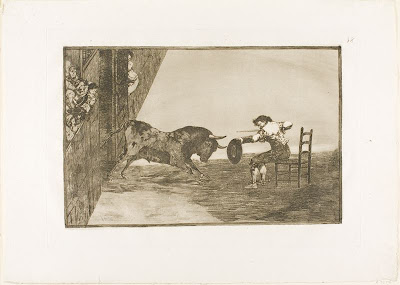One component of my internship for the Department of Prints and Drawings of the Art Institute of Chicago is to curate small selections of prints for the Allerton hallway spaces that serve as corridors for the main painting galleries.
There are a number of Allerton galleries to choose from, and each comes with its own subject matter. For instance, I curated gallery 219a, which is for Francisco de Goya, while my fellow intern Valerie Sullivan curated a gallery for 16th century Italian prints. Basically, I read about Goya for a few days in the Ryerson library, conceived of curatorial angles for each grouping, and then selected work for three rotations, one from each of Goya's main print series (The Art of Bullfighting, The Disasters of War, and The Caprices).
There are a number of Allerton galleries to choose from, and each comes with its own subject matter. For instance, I curated gallery 219a, which is for Francisco de Goya, while my fellow intern Valerie Sullivan curated a gallery for 16th century Italian prints. Basically, I read about Goya for a few days in the Ryerson library, conceived of curatorial angles for each grouping, and then selected work for three rotations, one from each of Goya's main print series (The Art of Bullfighting, The Disasters of War, and The Caprices).
The first rotation, from Tauromaquia or The Art of Bullfighting, was recently installed - go see it. Below are images of the prints, their tombstones, and two 'chats' or wall texts I wrote for accompaniment.
Francisco José de Goya y Lucientes
Spanish, 1746-1828 The agility and audacity of Juanito Apinani in the ring at Madrid,
plate 20 from La Tauromaquia (The Art of Bullfighting), 1814/16, published 1816
Etching and aquatint on ivory laid paperThe Charles Deering Collection, 1927.3378.20
From 1785 to 1814, the laws regulating bullfighting in Spain were changed four times by succeeding governments. These regulations varied wildly depending on the government’s political bent, ranging from outright prohibition to free admission for all. Due to its politicization, bullfighting became a useful metaphor for societal conflict, which Goya employed to obliquely comment upon the Spanish body politic. For instance, Goya often pictures the spectators as compositionally divided – either huddled in the right of the print or crowded to the left as in The agility an audacity of Juanito Apinani in the ring at Madrid, recalling stark divisions in Spanish society.
Spanish, 1746-1828 The agility and audacity of Juanito Apinani in the ring at Madrid,
plate 20 from La Tauromaquia (The Art of Bullfighting), 1814/16, published 1816
Etching and aquatint on ivory laid paperThe Charles Deering Collection, 1927.3378.20
From 1785 to 1814, the laws regulating bullfighting in Spain were changed four times by succeeding governments. These regulations varied wildly depending on the government’s political bent, ranging from outright prohibition to free admission for all. Due to its politicization, bullfighting became a useful metaphor for societal conflict, which Goya employed to obliquely comment upon the Spanish body politic. For instance, Goya often pictures the spectators as compositionally divided – either huddled in the right of the print or crowded to the left as in The agility an audacity of Juanito Apinani in the ring at Madrid, recalling stark divisions in Spanish society.
Francisco José de Goya y Lucientes
Spanish, 1746-1828 The unlucky death of Pepe Illo in the ring at Madrid,
plate 33 from La Tauromaquia (The Art of Bullfighting), 1814/16, published 1816
Etching, burnished aquatint, drypoint and burin on ivory laid paperThe Charles Deering Collection, 1927.3378.33
Goya was an enthusiastic bullfighting aficionado, and even claimed to have been a torero (bullfighter) in his younger years. Yet it’s unlikely that he meant this print series to be seen only as a fan’s outline of the history of bullfighting in Spain. In the early 19th century when Goya published these prints, bullfighting was a politically charged activity. It was seen either as bread and circus (or pan y toros (bread and bulls) as a reformist tract put it) meant to keep the populace distracted, or as an expression of Spanish nationalism – a spectacle imbued with patriotic fervor.
Spanish, 1746-1828 The unlucky death of Pepe Illo in the ring at Madrid,
plate 33 from La Tauromaquia (The Art of Bullfighting), 1814/16, published 1816
Etching, burnished aquatint, drypoint and burin on ivory laid paperThe Charles Deering Collection, 1927.3378.33
Goya was an enthusiastic bullfighting aficionado, and even claimed to have been a torero (bullfighter) in his younger years. Yet it’s unlikely that he meant this print series to be seen only as a fan’s outline of the history of bullfighting in Spain. In the early 19th century when Goya published these prints, bullfighting was a politically charged activity. It was seen either as bread and circus (or pan y toros (bread and bulls) as a reformist tract put it) meant to keep the populace distracted, or as an expression of Spanish nationalism – a spectacle imbued with patriotic fervor.









No comments:
Post a Comment